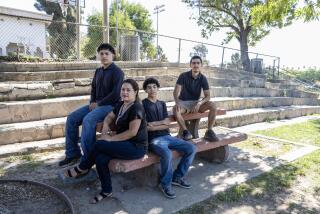Family separation litigation shifts to restoring migrant rights and preventing future crisis
- Share via
Reporting from San Diego — As the year draws to a close, the massive effort to reunify migrant families separated at the U.S.-Mexico border is nearly complete, yet the landmark litigation based in San Diego is far from over.
Some 2,100 families, both in the U.S. and abroad, have been reunified over the past six months.
It has been a logistical challenge — one of the government’s own making, a San Diego judge has repeatedly noted — that required enormous federal resources and scores of pro bono lawyers from around the country.
Now, with as few as eight remaining eligible children moving toward possible reunification, the focus of the case has shifted to restoring the rights of the migrants and to preventing such a crisis from happening again.
At the forefront is the implementation of a settlement agreement that allows reunited families still in the U.S. another chance to plead for asylum.
For many of the parents, their first credible fear interviews — which occurred shortly after being forcibly separated from their children, with little to no explanation — were disastrous. Parents were just too distraught to advocate for asylum to the interviewing officer.
So far, 127 reunited parents and children have been re-interviewed by asylum officers to determine whether their original findings should change, according to a joint status report filed in San Diego federal court this month. Most, if not all, of those families have been detained together in immigration custody.
Hundreds more reunited parents and children who have been released on parole into the community are in the process of being notified of their right to such an interview.
What is unknown is the outcome of those re-interviews. The Department of Justice, which has been litigating the case on behalf of the Trump administration, has been reluctant to release numbers on how many asylum decisions have changed as a result of the settlement.
Lawyers for the migrants have argued that it is a matter of transparency and a way to monitor how the government has been implementing the settlement agreement. Lawyers for the government have called the data request too burdensome.
On Dec. 14, U.S. District Judge Dana Sabraw ordered the data to be released.
With the federal government shutdown, it’s unclear when that will occur. All deadlines in this case, and other non-essential civil cases, have been stayed as a result of the failure to reach a federal budget deal.
The next scheduled court hearing is Friday, and it is unknown whether that will remain on the calendar.
Another legal battle is brewing as to who is considered a class member. While attorneys have identified roughly 2,600 children as being part of the case, more families continue to come forward with unique circumstances of separation, asking for relief under the litigation.
Some of those families were reunited before Sabraw’s June 26 injunction against separation. Lawyers for the migrants argue those families should not be excluded from getting new interviews, while the government maintains the class contains only those who were still separated when the injunction was filed.
Meanwhile, there are still more than 100 separated children in government care.
Rather than be reunited with parents, these children are still waiting to be placed with sponsors — often extended family or friends — in the United States to try for asylum.
Twenty-eight of these children have parents who were deemed to be unfit or a danger. An additional 84 children have parents who were deported and have waived reunification, many hoping their child will have a better opportunity in the U.S. than back home in dangerous and impoverished Central American countries.
Eleven parents who remain in the U.S. have also waived reunification.
The sponsorship process has been slow going for many children as the government conducts background checks on the potential sponsors.
Already, 377 other separated children either have been placed with sponsors or have turned 18, therefore aging out of the system.
There are indications the litigation is beginning to move into its final stages.
Sabraw has asked the lawyers to begin to work on the last piece of his ruling: to come up with a system that links parent and child upon apprehension or surrender at the border.
The lack of such a system is largely blamed for creating the family separation crisis during the Trump administration’s zero tolerance policy. When parents were either arrested to be criminally prosecuted for illegal entry or detained upon claiming asylum at a port of entry, there was often no notation that they had come with a child.
Children were taken to government shelters without indication that they had come with parents.
When parents were released from criminal custody, many couldn’t find out where their children had been taken. Parents were deported, leaving their children behind.
Sabraw is encouraging the government to implement a central database, accessible to all of the agencies that may touch the immigration system at some point: Justice, Homeland Security, Health and Human Services, Customs and Border Protection and Immigration and Customs Enforcement.
While authorities may under law separate families while a parent goes into criminal custody, Sabraw ordered that the reunification process be started immediately upon the parent’s release.
Davis writes for the San Diego Union-Tribune
More to Read
Sign up for Essential California
The most important California stories and recommendations in your inbox every morning.
You may occasionally receive promotional content from the Los Angeles Times.










